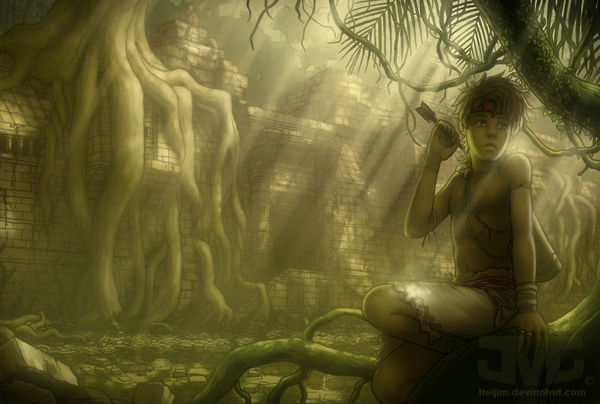Keid
The Keid are a race not quite considered human. They live all throughout the jungles of Jindiara and mainly consist of the Shaai, Gexri, and Ngoed groups. The largest are the Gexri, and the father of the Keid, Buroba, is said to live among them. Very little contact has been made with the Keid. Buroba is not only their creator but also their immortal king, often regarded as a Hireos. The two largest structures in the region are Genxren, where Buroba dwells in the city of Shuptalxia, and Daarbang, a mighty stone wall in the eastern jungle said to keep their Fanoran enemies at bay.
Appearance and Ability
Keid appear mostly human. They are athletic and strong by nature, and are on average 30-50% taller than the average human. Hair is usually kept long, tied into ponytails and tamed with headbands. Feathers of the koatl bird are worn in the headband indicate the age of the Keid; every Keid gets a feather for being born, and one for every five years they are alive. This rule also applies to Buroba, who has an enormous trailing headdress made of feathers. Clothing is kept simple and pragmatic: belts, loincloths, skirts, armbands, boots, gloves, and other such adornments are common. Some Keid have hyperpigmentation of the extremities, making their forearms and lower legs appear darker with a dark green or dark brown hue. Additionally, their green eyes sometimes appear to dimly glow in low light.
Keid possess the innate ability to breathe without using their lungs. It is believed that Buroba, being a wind spirit, is able to give Keid air without them needing to breathe. Buroba himself is said to not require breathing. It makes them very formidable at any physical activity, given that they are not held back by needing to breathe heavier to get more air, and can supposedly swim for hours without needing to resurface for air. It also improves their abilities with archery, as their breathing can be turned off to allow them to aim better.
Some Keid also seem to have a very advanced form of telekinesis but only applied to arrows. Once fired, a skilled Keid archer can adjust the flight path of their arrow. Though it isn't believed they can stop or slow the arrow's flight, having the ability to curve the path makes them even more dangerous archers. It isn't known whether this ability is tied to their bodies, their bows, or their arrows. Human reflexes are not believed to be good enough to be able to perform this ability, even if they were able.
Lifestyle
Among Keid cultures, the concept of biological family is nonexistent. Keid live communally, sharing whatever spaces they want in whatever groups they want. A home could contain biologically related Keid as often as it could contain only children, or only warriors or hunters. Keid also seem to have no concept of marriage, and breed as they please for the sake of bettering their community.
Keid have several cities, mostly consisting of a few stone temples surrounded by networks of stilt houses, walkways, and treehouses. Other Keid live in communities of varying sizes. Some larger communities have a few stone buildings that act as barracks, storehouses, or small temples. Other known Keid cities include Pzentelka and Emuxutalfa.
Wind instruments are very common among the Keid, and it is said that humans cannot play their music, as they can play a note indefinitely thanks to their abilities. The instruments are usually complemented with percussion and vocals.
Beliefs
The Keid believe in two deities. One is their leader, Buroba, who walks among them in the form of a fellow giant Keid. The other is Maaloxtodin. To the Keid, Maaloxtodin is a kind of grandfather god. He is believed to be the creator of Buroba, and is also once thought to have complete power over the world. Maaloxtodin comprises one of two essential components to Keid life by representing water. Buroba represents air to breathe. Keid either believe in both deities or in neither deities. The closer a Keid lives to Shuptalxia, the more likely it is that they believe, as it is more likely that they have seen or know someone who has seen or met Buroba. Those who don't believe are simply ignorant, and generally live in smaller, more remote villages.
Maaloxtodin lost the power to govern the world when he saved the early Keid people from a malicious spirit called Faatox. Faatox was believed to be a raman (bad) spirit who tried to chase Buroba from the depths of the earth, which was where Buroba went to acquire eternal life and the ability to control the wind. In these depths is a corroded cavern now known as Pzapzo. It's believed that Faatox was the one who caused Pzapzo to corrode, as he carelessly clawed his way out of the black depths of the world to chase Buroba. Buroba fled and made a plea to his father, Maaloxtodin, to intervene and protect him from Faatox. Maaloxtodin emerged from the sky and struck Faatox over the head with such force that the whole world shook and the entrance to the cave that led to Pzapzo was covered in giant stones. The contact with Faatox had killed the raman spirit, but it had also sapped much of Maaloxtodin's energy. So Maaloxtodin had to stay far away from the world so that he wouldn't spend any power, and he watches over the Keid from a distance.
Some Keid believe that Faatox reemerged in the form of Gehmakemn, the ruler of the Fanoran people.
